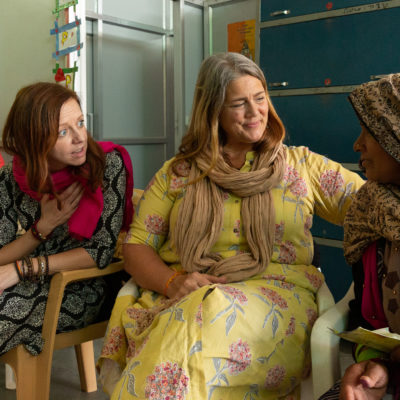Vulnerability: Why It’s Hard to Embrace It and How to Lean In
I have always hated the palm-sweating, stomach-clenching, wobbly-voice feeling of being vulnerable. The word “vulnerable” is enough to make me start squirming in my seat.
In 2010, I saw a TED Talk by Brené Brown – a researcher and author focused on vulnerability – that really struck a chord. Brené shared how after years of research, she found that vulnerability is the birthplace of joy, creativity, belonging, and love – despite her own predisposition to fear it and human tendencies to numb it.
 This idea, that I should embrace vulnerability, was not easy for me to accept.
This idea, that I should embrace vulnerability, was not easy for me to accept.
I was a particularly sensitive child due to some trauma I experienced and I cried a lot. This kind of emotion did not go over well with my stiff-upper-lip household. Being labeled a “wimp” forced me to develop a thick skin. So as I grew older, even when I cried, I did everything in my power to pull myself together and never let anyone see the mess. On the rare occasions when the tears spilled out in front of someone else – like after a particularly bad heartbreak or post-cancer diagnosis – I would feel a hot flush of shame and clench my fists, pressing my fingernails into my palms until the pain forced me to gain my composure. Or, I found a reason to excuse myself from the room until I could collect my emotions.
Don’t get me wrong, there are benefits to developing a tough exterior. I am grateful that I learned independence and self-reliance. But, I also learned to guard against anyone really seeing me. I learned to keep the more challenging aspects of my story a secret.
Our stories are vast and complex with scenes, characters, and plot lines that we’d rather forget.
But, what if there is a way out of the difficult parts of our stories? What if practicing vulnerability is actually a ticket to freedom?
Accepting my own vulnerability
Years ago, when I was struggling with a particularly painful part of my story and would have given anything to tuck it neatly back onto a dark shelf in the back of my mind, my psychologist gently said to me, “Terri, the only way out is through.” She taught me that I had to unpack the story and feel the emotions around it in order for it to stop having power over me.
Over the past ten years, I have challenged myself to be vulnerable – first with my psychologist, then with myself, and gradually with the people closest to me. I don’t let people in easily and it takes time for someone to earn the right for me to be vulnerable with them. But when I do let them in, I feel compassion and a softening – rather than judgment.
 We’re all scared that if people knew everything about us, including the not-so-perfect parts, we’d end up alone. Relegated to some scrap yard for frauds. For many of us, this idea comes as a double standard because we want to comfort others. It begs the question: if we like nurturing others, why is it so hard to allow ourselves to be nurtured?
We’re all scared that if people knew everything about us, including the not-so-perfect parts, we’d end up alone. Relegated to some scrap yard for frauds. For many of us, this idea comes as a double standard because we want to comfort others. It begs the question: if we like nurturing others, why is it so hard to allow ourselves to be nurtured?
In practicing my own vulnerability and facilitating nearly 20 A Fresh Chapter programs, I’ve seen the liberation that happens when we share parts of our stories and hear other people’s stories of hardship, realizing that we’re all imperfect. It’s this recognition of our human frailty that helps us see ourselves with more compassion.
Where to begin
So, how do you begin leaning into a concept that has you sweating and feeling like you might be sick to your stomach?
What if you could start small and enlist the help of others – the same way you would if you were learning a new language or developing any other skill?
For me, the right psychologist was critical in uncovering the pieces of my story that had become too heavy to carry. She encouraged me to start with being vulnerable with myself. I practiced by challenging myself to write what I was really thinking in my journal instead of what I’d want someone to read if, god forbid, someone cracked the cover and started reading my words.
Next, I started practicing being vulnerable with others (and, I’ll admit, this one has been harder). Now, when I’m with someone and feel emotions coming up, instead of immediately squashing them, I ask myself ‘has this person given me any indication that it would be safe to share more with them?’ If the answer is yes, I take some deep breaths and acknowledge that my palms are sweating and my heart is beating fast while I allow the tears or emotions to come up and I share just a piece of what I’m feeling. Depending on the response, I decide if I will share more next time.
Ease in
Most of us want deeper connections. To feel loved, seen, and valued. So, why not jump in full tilt? After all, Brown says that connection only happens when we allow ourselves to be vulnerable.
 The tricky part is that it doesn’t always work. We have no control over how the other person might respond. Sometimes you share something and the other person’s reaction is shock or judgment. This kind of reaction feels crippling and can leave us with a “hangover” far worse than those induced by alcohol. We might feel more isolated or ashamed and like we never want to share anything ever again. When this happens, I remind myself that often a judgmental reaction from someone else has nothing to do with me and everything to do with a part of their story that they don’t want to see.
The tricky part is that it doesn’t always work. We have no control over how the other person might respond. Sometimes you share something and the other person’s reaction is shock or judgment. This kind of reaction feels crippling and can leave us with a “hangover” far worse than those induced by alcohol. We might feel more isolated or ashamed and like we never want to share anything ever again. When this happens, I remind myself that often a judgmental reaction from someone else has nothing to do with me and everything to do with a part of their story that they don’t want to see.
By easing in, and giving people time to earn your trust, you can reduce the downside. You also give them permission to show you their less-than-perfect selves. In this, there is freedom and connection. This is what Brené means when she says vulnerability is the birthplace of belonging.
To be seen and loved – even when we’re not perfect – is the gift we’re all searching for. When someone truly listens and shows up for us with no judgments or preconceived notions of what we should do or who we ought to be – that feels an awful lot like coming home.



No Comments